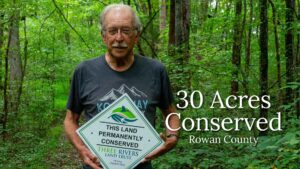
by Crystal Cockman
November 2, 2016
Our state has a great diversity of wildlife and habitats. There are various sources of funding associated with protecting game species like white-tailed deer and wild turkey and various sport fish, including the Wildlife Restoration Act (Pittman–Robertson or PR), Sport Fisheries Restoration Act (Dingell–Johnson or DJ), and the Wallop-Breaux Act. Less funding has been available for what are known as “nongame” species. These are species like migratory songbirds and aquatic mussels that are not fished or hunted.
In the mid-1990s the Teaming with Wildlife Coalition was formed to help secure funding for preservation of these nongame species. From their work with members of Congress, the Department of the Interior and Related Agencies Appropriation Act was developed and signed into law in 2002. This act created the Wildlife Conservation and Restoration Program and the State Wildlife Grants Program (or SWG), which provides federal matching funds to all 50 states and territories. These funds are used to protect species and prevent them from becoming endangered, or to help keep common animals common.
The SWG program provides funding for conservation of nongame species, but each state must have a State Wildlife Action Plan in order to be eligible for these funds. North Carolina’s Wildlife Action Plan (NCWAP) is “a comprehensive planning tool developed by the N.C. Wildlife Resources Commission to help conserve and enhance the state’s full array of fish and wildlife species and their habitats.” It was developed in cooperation with numerous partners, including federal and state agencies, conservation organizations, and various other stakeholders. The N.C. Wildlife Resources Commission received approval from the U.S. Fish & Wildlife Service for the comprehensive revision of the N.C. Wildlife Action Plan on March 30, 2016.
One change in the new NCWAP is the incorporation of the effects of climate change on wildlife. The second version of the NCWAP is the result of a lot of collaborative efforts of federal and state agencies, local organizations, and citizens. This involved the “development of committees, review of literature and guidance documents, review and revision of the species evaluation and prioritization process, and investigation of the technical publication resources.” A State Wildlife Action Plan Best Practices Working Group was created to help improve and standardize these plans across the states. NCWRC incorporated many of these best practices in this new revision.
There are eight required elements in this new plan. These are 1) Distribution and abundance of species of wildlife, 2) Descriptions of locations and relative condition of key habitats and community types, 3) Descriptions of problems and priority research and survey efforts needed, 4) Descriptions of conservation actions proposed to conserve species and habitats, 5) Monitoring plans and adaptation of conservation actions, 6) Procedures for review of the Plan at intervals not to exceed 10 years, 7) Plans for coordinating the development, implementation, review, and revision of the Plan with federal, state, and local agencies and Indian tribes, and 8) Documentation of public participation during development and implementation.

The first wildlife action plan helped guide wildlife conservation efforts, and in one case study implementing the recommendations from the 2005 plan helped improve knowledge about Carolina Northern Flying Squirrels, which led to positive results from conservation efforts.
There are currently 61 wildlife and plant species in North Carolina that are listed for protection under the Federal Endangered Species Act. There are 109 species listed as threatened or endangered in North Carolina. Since the 2005 WAP there have been changes in the species protected under federal and state listings. For example, the Bald Eagle was delisted. The Northern Long-eared Bat was listed as Threatened. There are also what are considered endangered ecosystems, such as the Longleaf Pine savanna and Southern forested wetlands.
The WAP provides information about conservation and management needs of North Carolina’s fish and wildlife and the natural communities in which they live, prioritizes recommendations for meeting those needs, and identifies programs and partnerships that work toward achieving those goals. In the case of the Northern Carolina Flying Squirrel, the 2005 WAP identified the need for surveys to determine their distribution, abundance and status. Monitoring and genetic research were also needed.
Habitat loss of the spruce-fir forest from logging and development and the Balsam and Hemlock Woolly Adelgid threaten this species. In addition, the Cherohala Skyway corridor in the Unicoi Mountains resulted in a barrier to dispersal that impeded genetic mixing of populations, because the road was too wide for the squirrels to glide across. Replanting areas with Red Spruce and the installation of artificial crossing structures across the skyway have helped restore habitat and reconnect populations of the squirrel. This is just one real-world example of how conservation actions can be implemented to help protect and restore species. Keeping common animals common as a goal of the WAP helps species before they become threatened or endangered. This insures they will be around for future generations and to continue to play important roles in the ecosystems in which they live. The WAP is one important tool in making that a reality.